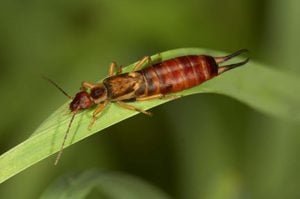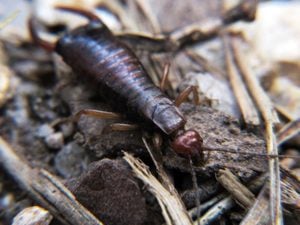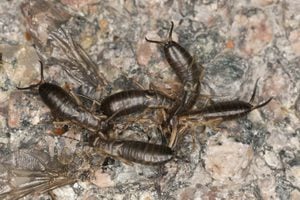Earwigs: A Pest Control Guide for the "Pincher Bug"
Finding an earwig in the habitation can be a startling encounter due to their distinguished pincers. But these common household pests should not be feared. Read on to learn why.

Getting their name from the side to side body movement and an old tale of crawling in people's ears, the earwig is a common and distinguishable household pest causing angst to homeowners for many years. The ecological scavengers of the insect earth, earwigs clean homes and gardens everywhere, feasting on dead and decomposable found life and insects. While an earwig's presence provides order to their environment, an equal amount of anarchy tin also follow.
How to Identify Earwigs
Often referred to equally the "Pincher Bug", the earwig is a pest you won't soon forget nor have problem identifying when yous see one. With intimidating pincers, long antennas, and a anticipated lifestyle, yous tin detect these creepy crawlers in and around your abode when the environment suits them. Knowing who and what they are makes encountering an earwig a harmless circumstance.
What are earwigs?
Earwigs are a nocturnal insect that make up the Greek designated Dermaptera order ("peel wings"). With more than xx species of Earwigs in the United States solitary, earwigs appear on all continents save for Antarctica. Earwigs are commonly known for the mythical story of "crawling into people'due south ear" – something of which has non been proven to be scientifically correct – yet the pincers on the back of their abdomen can affright the average homeowner.
What do earwigs expect like?
Earwigs are a unique looking insect, noticeable most by their big cerci, otherwise characterized as pincers. These pincers, while harmless to people, develop from their abdomens and are used for cocky-defense. Past the finish of an earwig'southward life cycle, they typically size effectually ½-1-inch-long and have a low-cal to nighttime brownish exterior. Along with their pincers, they accept 6 legs, two long antennae that protrude from the top of their head and two pairs of wings, which often hibernate under a thick encompass. Even though virtually species of earwigs have wings, they often practice not utilise the ability to fly, and generally resort to their legs for getting from point A to signal B.

Types of Earwigs
With over twenty species of earwigs found just in the U.s.a., there are many more than that dwell in or near homes all over the world. The European earwig (Forficula auricularia Linnaeus) is the type of earwig showcased above and most ordinarily identified within the United States. Additional types of earwigs include the Red-Legged earwig, the Striped earwig, the Maritime earwig, the St. Helena (Giant) earwig and Seashore earwigs. The majority of earwig species concur similarities of body blazon that include pincers, long antennas and a slender frame.
Earwig Habitat
While earwigs are present all over the globe, finding them just requires agreement how they live and operate. As a scavenger looking to protect their own cocky-interest for most of their life, earwigs look to find a healthy supply of food along with a safe and protective environment from dangerous elements.
What exercise earwigs swallow?
Earwigs are typically omnivores that will feed on plant life, other insects, pollens, and lichens. Earwigs can create havoc in gardens due to their preferred nutrient source of plants and flowers. They volition feed on soft foods and fruits such apricots, vegetables, plants, and fifty-fifty some flowers. While earwigs use their pincers to hunt arthropods, they are very much a scavenger insect themselves. The nocturnal pest feasts on things such as mites, expressionless leaves, insect eggs, and other dead insects.
Earwig surroundings
Earwigs are an outdoor, nocturnal insect that prefer a cool, moist location to live in. Outside, you tin find earwigs in places such as an onetime wood piles, under rocks, in the garden or in leaf piles. The females will ever reproduce outdoors, preferring to lay their eggs within the soil or a minor crevice. While living exterior is where earwigs are most oft establish, they tin become indoors unless by modes of transportation such as bags or trash.

Occasionally, earwigs will wander into a house through cracks or open crevices in order to escape inhospitable conditions such as hot weather and dry air. They await for spots such equally a absurd basement that offer the moist environs they desire. As mentioned, earwigs are a nocturnal insect, meaning they typically lie low and slumber during the day while coming out during the night to feed and hunt. Most earwigs are attracted to lite, so it's possible you detect many of them at night surrounding a vivid porch light.
Where do earwigs alive?
Earwigs live all over the globe with the only exception of Antarctica. The common earwig is located all over the United States, only generally is more frequent in the s and southwestern states. Earwigs practise not fare well in cold environments, with only a few species residing in the northern atmosphere. Based on what country you alive in and where you alive in that land, y'all can possibly encounter several different types of earwigs.
How to Remove Earwigs
The terrifying look of earwigs combined with their potentially nuisance behavior in the gardens tin lead any homeowner on a search for answers to getting rid of these unwanted pests. In just a few steps, y'all tin can know what it will have to become rid of earwigs and keep them from coming back.
Signs of earwigs
Earwigs adopt a absurd and damp environment to live and feast in. Outdoors, y'all tin can notice them in organic locations such as mulch, dead leaves, stones, or logs. They often like to feed on plants, making gardens with an abundance of food source a good dwelling to military camp out in. In the business firm, locations such every bit a absurd basement, room with a leak in it, or any location that offers that hospitable environment. Earwigs will enter through cracks in the foundation, windows, or other open crevices.
Earwig infestations
Earwigs are non an insect that you will typically find in large numbers. Dissimilar to insects like ants or bees, earwigs are more individual creatures. They don't have a queen or colony that they belong to, thus making earwig infestations quite rare. Living environment will often be a common denominator for finding a larger number of earwigs in one identify. They live outdoors and want to stay away from the dry, hot sun. Its possible to discover a few together in places such as leaf or wood piles where there is an abundance of nutrient and protection.

Indoors, you may detect a few strays leaving their outdoor homes for a dainty moisture and cool environment, such as a basement with a leak or pile of wet towels. Finding them indoors tin can be worrisome for a homeowner, but relief can be constitute knowing they are most likely an outdoor insect temporarily seeking asylum in your house.
Earwig pest control
Earwigs tin can be unpleasant to notice in the home and a problem to constitute life in the garden. If you come beyond a few, in that location are more than than a few methods that can help get rid of earwigs. Making a trap that consists of oil and soy sauce can be used to lure the insects and drown them. Alcohol-based insecticide sprays is a manner to quickly kill earwigs visible and onsite. Birds and frogs are natural predators of earwigs, thus creating a habitat for them can be a tedious only natural remedy for removing earwigs. For those earwigs in the business firm, vacuuming is a uncomplicated solution for killing the ones you crawling on the floor.
Earwigs desire a rubber habitation to hide in throughout the day while they exit and feed at dark. They ofttimes will be more prevalent in rainy seasons and found in moist locations that offering that blazon of ideal living infinite.To prevent earwigs in the yard and garden, effort to remove their platonic resting locations. Get rid of foliage piles, one-time wood, mulch build up, and other excess vegetation. Keep gutters and downspouts make clean and pointed away from the home to avert damp or moist locations building upward in and against the house.
To keep earwigs out of the home, check the foundation for cracks or holes, windows that don't close all the way or have gaps in the screens, and whatsoever other unplanned entrances to the home. The fundamental to preventing earwigs from living in or effectually the firm is to create an inhospitable environs for them. Cleanliness, open spaces, and dry air is the verbal contrary of what an earwig is looking for.
Earwig Prophylactic
While earwigs may look similar 1 the dangerous insects within your habitation because of the pincers protruding from their back, they are actually quite harmless to people. If an earwig does crawl on you, it is possible that they might use their pincers to pinch the skin out of cocky-defense. An earwig's compression could potentially cause slight discomfort and in rare cases penetrate the pare. If this were to occur, simple treatment with soap and water along with an antibiotic foam to prevent infection would be all that is necessary.
Earwigs practice not take a stinger of any sort and thus do not carry venom. They are not poisonous. And reverse to an sometime wives' tale, at that place is no additional risk of earwigs crawling into 1's ear. While quite harmless, an earwig might not be a pest you want to proceed around the home. For more advanced earwig control treatment, contact your local pest exterminator to evaluate and provide solutions for your unique situation.
Boosted Earwig Information
For more than data about earwigs and what it means when y'all find this pest in your home, check out these pest control articles.
- Earwig Guide
- Types of Earwigs
- Earwig Life Cycle
- Earwig Infestations
- How to Get Rid of Earwigs
- How to Prevent Earwigs
- Earwig Safety
- Earwig Facts
Sources:
- https://world wide web.almanac.com/pest/earwigs
- https://www.insectidentification.org/earwigs.asp
- https://extension.umn.edu/nuisance-insects/earwigs#life-wheel-of-earwigs-1241661
trowbridgeyousand.blogspot.com
Source: https://www.familyhandyman.com/article/earwigs-guide/
0 Response to "Earwigs: A Pest Control Guide for the "Pincher Bug""
Post a Comment